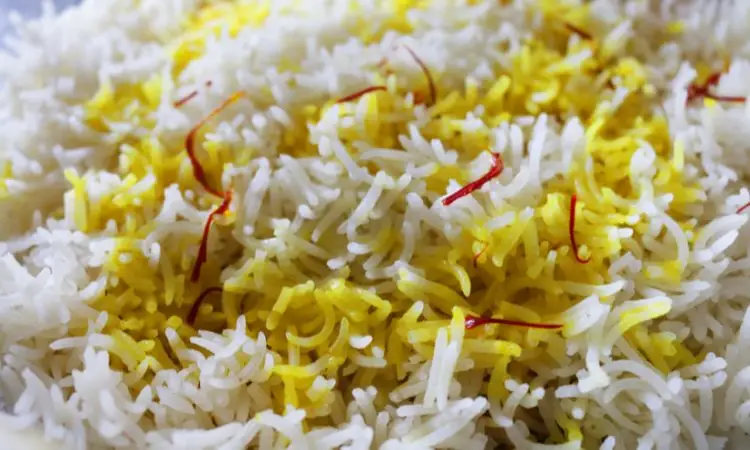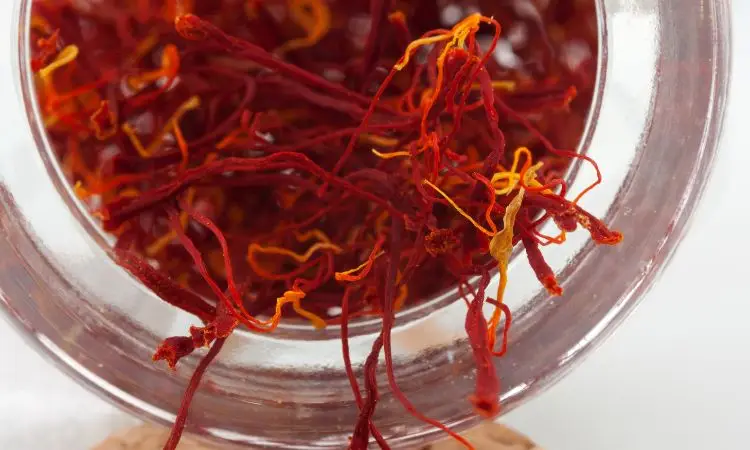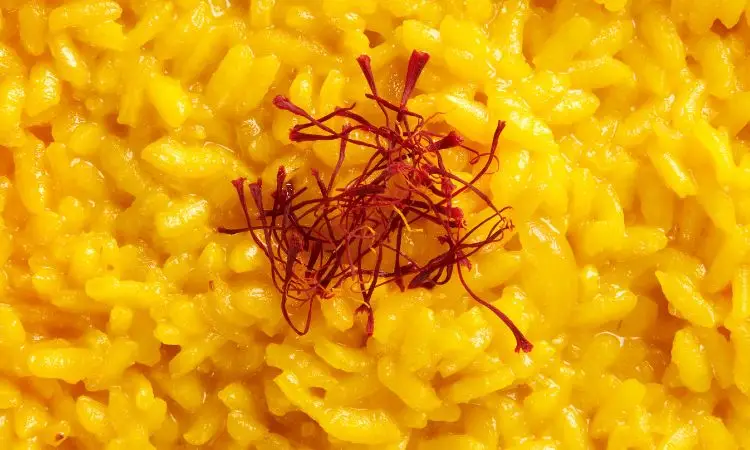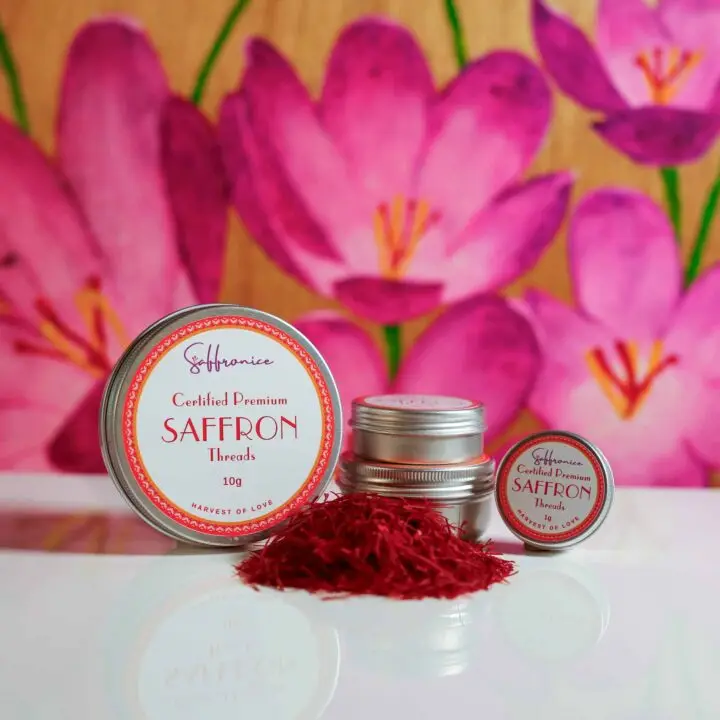Saffron, the world’s most precious spice, transforms ordinary dishes into extraordinary culinary experiences with its distinctive aroma, vibrant color, and complex flavor profile. Learning what saffron truly is and how to cook with it properly unlocks the full potential of this golden treasure in your kitchen.
This comprehensive guide explores essential techniques, from basic preparation methods to advanced culinary applications, ensuring you maximize both flavor and value from every precious strand.
📌 Quick Answer: Toast saffron threads, grind them, then steep in warm liquid for 10-15 minutes before adding to dishes. Use 1/4 teaspoon for 4-6 servings. Store properly and buy from reputable sources for the best results.
🔑 Key Takeaways:
- Master proper saffron preparation techniques for maximum flavor extraction
- Learn optimal cooking methods for different dish types
- Understand storage and handling for quality preservation
- Discover classic and modern applications across cuisines
- Apply expert tips for consistent culinary success

Understanding Saffron as a Culinary Spice
Saffron comes from the dried stigmas of Crocus sativus flowers, requiring approximately 150-200 flowers to produce just one gram of spice. This labor-intensive harvesting process, combined with saffron’s unique properties, makes it the world’s most expensive spice by weight.
Chef’s Professional Tip: During my culinary career, I’ve learned that understanding saffron’s delicate nature is crucial for successful cooking. Proper technique can make a small amount go far, while improper handling wastes this precious ingredient.
Food Scientist’s Note: Saffron’s flavor compounds—crocin, picrocrocin, and safranal—require specific preparation methods to release their full potential. These volatile compounds are sensitive to heat, light, and time.
Meeting saffron quality standards ensures optimal cooking results. High-quality saffron displays deep red threads with minimal yellow or white portions, indicating proper processing and storage.
Essential Saffron Components
Each saffron thread contains:
- Crocin – provides a distinctive golden color
- Picrocrocin – contributes bitter-sweet taste
- Safranal – creates a characteristic aroma
Understanding these compounds helps optimize cooking techniques and timing for maximum flavor impact.
Fundamental Preparation Techniques
Proper saffron preparation forms the foundation of successful cooking with this precious spice. Professional techniques ensure optimal flavor extraction while maximizing value.
The Three-Step Preparation Method
Step 1: Toasting Gently warm saffron threads in a dry pan for 10-15 seconds. This brief heat exposure activates essential oils and intensifies aroma without damaging delicate compounds.
Step 2: Grinding Crush toasted threads using a mortar and pestle. This mechanical breakdown releases trapped oils and increases surface area for better liquid extraction.
Step 3: Steeping Dissolve ground saffron in 2-3 tablespoons of warm liquid (water, stock, or milk) for 10-15 minutes. This creates “liquid saffron” that distributes evenly throughout dishes.
| Preparation Stage | Duration | Temperature | Purpose |
|---|---|---|---|
| Toasting | 10-15 seconds | Low heat | Activate oils |
| Grinding | 30-60 seconds | Room temperature | Increase surface area |
| Steeping | 10-15 minutes | Warm (not boiling |
| Preparation Stage | Duration | Temperature | Purpose |
|---|---|---|---|
| Toasting | 10-15 seconds | Low heat | Activate oils |
| Grinding | 30-60 seconds | Room temperature | Increase surface area |
| Steeping | 10-15 minutes | Warm (not boiling) | Extract compounds |
Proper saffron storage methods before preparation ensure maximum potency and flavor extraction.
Alternative Preparation Methods
Direct Addition Method: For liquid-heavy dishes like soups or stews, add whole threads directly to simmering liquids. Allow 15-20 minutes of cooking time for full extraction.
Milk Infusion Method: Steep saffron in warm milk for desserts and cream-based dishes. This method works particularly well for ice creams and puddings.
Oil Infusion Method: Combine saffron with neutral oil for applications requiring fat-soluble flavor distribution.
Cooking Applications by Dish Type
Understanding how saffron behaves in different cooking environments enables optimal application across various dish categories.
Rice Dishes and Grains
Saffron transforms rice dishes into visually stunning and aromatic centerpieces. The key lies in proper timing and liquid distribution.
Classic Saffron Rice Technique:
- Prepare liquid saffron using the three-step method
- Add to the cooking liquid before the rice
- Maintain a gentle simmer to preserve delicate compounds
- Allow 5-10 minutes resting time after cooking
Professional saffron rice dishes showcase various regional techniques, from Persian tahdig to Spanish paella, each requiring specific timing and preparation methods.
Desserts and Sweet Applications
Saffron’s complex flavor profile complements both dairy-based and fruit-forward desserts. Understanding the distinctive aroma and flavor helps balance sweetness with saffron’s subtle bitterness.
Dessert Application Guidelines:
- Ice creams: Steep in warm cream base before churning
- Puddings: Add during the initial heating phase
- Baked goods: Incorporate into liquid ingredients
- Candies: Dissolve in minimal liquid before adding
Explore specialized saffron dessert recipes for detailed techniques and proportions.
Savory Dishes and Proteins
Saffron enhances savory dishes through careful integration with complementary flavors. The spice pairs particularly well with seafood, poultry, and lamb.
Protein Cooking Methods:
- Marinades: Include liquid saffron in acidic marinades
- Braising liquids: Add during the initial searing phase
- Roasting: Apply saffron-infused oils or butters
- Grilling: Create saffron-based glazes
Regional Cooking Traditions
Different culinary traditions have developed unique approaches to cooking with saffron, each offering valuable techniques and flavor combinations.
Persian Cuisine Applications
Persian cooking extensively utilizes “liquid saffron” as a finishing element. Traditional Persian saffron cuisine emphasizes saffron’s visual impact alongside its flavor contribution.
Key Persian Techniques:
- Tahdig preparation: Saffron-infused rice bottom for crispy texture
- Khoresht applications: Stew finishing for color and aroma
- Polo dishes: Layered rice with saffron distribution
- Dessert integration: Delicate flavoring for traditional sweets
Mediterranean Cooking Methods
Mediterranean cuisines, particularly Spanish and French traditions, integrate saffron into hearty, rustic dishes where the spice’s earthiness complements robust flavors.
Mediterranean Applications:
- Paella techniques: Early addition for maximum infusion
- Bouillabaisse preparation: Aromatic base development
- Risotto methods: Gradual incorporation with stock
- Bread applications: Dough enhancement for color and flavor
Indian Culinary Traditions
Indian cooking often combines saffron with milk-based preparations and aromatic spice blends, creating complex flavor profiles that highlight saffron’s versatility.
Expert Cooking Tips and Techniques
Professional techniques ensure consistent results and maximize saffron’s culinary impact while respecting its precious nature.
Flavor Pairing Strategies
Understanding saffron spice pairing principles enables creative combinations while maintaining flavor balance.
Complementary Pairings:
- Sweet: Cardamom, rose water, vanilla, almonds
- Savory: Garlic, onions, tomatoes, white wine
- Proteins: Seafood, chicken, lamb, goat cheese
- Vegetables: Fennel, leeks, potatoes, eggplant
Timing and Temperature Control
Saffron’s volatile compounds require careful timing to prevent degradation while ensuring full extraction.
Critical Timing Guidelines:
- Addition timing: Add early for color, late for aroma
- Temperature limits: Avoid boiling temperatures above 200°F
- Cooking duration: Minimum 15 minutes for full extraction
- Resting periods: Allow flavors to meld after cooking
Professional saffron seasoning tips provide additional guidance for optimal timing and application.
Quantity Guidelines and Dosage
Proper proportioning ensures flavor balance while maximizing value from this expensive spice.
Standard Proportions:
- Rice dishes: 1/4 teaspoon per 4-6 servings
- Soups/stews: 1/8 teaspoon per quart
- Desserts: 1/8 teaspoon per 2 cups liquid
- Beverages: Pinch per serving
Understanding saffron’s daily dosage helps maintain both culinary and health considerations.

Storage and Preservation for Cooking
Proper storage maintains saffron’s cooking properties and prevents quality degradation that affects culinary results.
Optimal Storage Conditions
Following professional saffron preservation tips ensures consistent cooking quality over extended periods.
Storage Requirements:
- Temperature: Cool, stable conditions (50-70°F)
- Humidity: Low moisture environments (30-50% RH)
- Light: Dark storage locations
- Containers: Airtight, opaque materials
Prepared Saffron Storage
Liquid saffron requires different storage considerations than whole threads.
Liquid Saffron Storage:
- Refrigerate in airtight containers
- Use within 2-3 days for optimal potency
- Freeze in ice cube trays for longer storage
- Label with preparation date
Modern Culinary Applications
Contemporary cooking techniques expand traditional saffron applications while respecting classical preparation principles.
Beverage Applications
Saffron’s versatility extends to both hot and cold beverages, from traditional teas to modern cocktails.
Beverage Techniques:
- Hot preparations: Steep in brewing liquids
- Cold applications: Pre-infuse in syrups
- Alcoholic drinks: Tincture preparation methods
- Non-alcoholic options: Flavored waters and teas
Explore saffron tea benefits and saffron-infused drinks for specific recipes and techniques.
Contemporary Fusion Cooking
Modern chefs incorporate saffron into unexpected applications while maintaining respect for traditional techniques.
Innovation Areas:
- Molecular gastronomy: Saffron foams and gels
- Fermentation: Saffron-enhanced pickles and preserves
- Smoking techniques: Aromatic enhancement methods
- Plating presentations: Visual impact considerations
Sourcing and Quality Considerations
Successful cooking with saffron begins with quality sourcing and proper supplier selection.
Quality Assessment for Cooking
Understanding quality indicators ensures optimal cooking results and value maximization.
Quality Indicators:
- Visual appearance: Deep red threads with minimal yellow
- Aroma intensity: Strong, characteristic fragrance
- Thread integrity: Minimal breakage and powder
- Origin verification: Reputable supplier documentation
Professional sourcing from reputable suppliers provides quality assurance for culinary applications.
Cost-Effective Usage Strategies
Maximizing value requires understanding proper proportions and preparation techniques that extract maximum flavor from minimal quantities.
Value Maximization:
- Preparation optimization: Complete extraction techniques
- Portion control: Accurate measurement methods
- Storage protection: Quality preservation practices
- Application timing: Optimal flavor development
Troubleshooting Common Cooking Issues
Understanding common problems and their solutions ensures consistent cooking success with saffron.
Flavor Problems
Weak Flavor: Often indicates insufficient preparation time or poor-quality saffron. Extend steeping time or increase quantity slightly.
Bitter Taste: Usually results from excessive heat or over-extraction. Reduce cooking temperature and steeping time.
Uneven Distribution: Indicates improper liquid saffron preparation. Ensure complete dissolution before adding to dishes.
Visual Issues
Poor Color Development: Suggests inadequate preparation or inferior quality saffron. Verify preparation technique and source quality.
Color Fading: Often occurs with excessive heat or extended cooking times. Add saffron later in the cooking process.
Expert Recommendations
Chef’s Wisdom: Treat saffron like a fine wine—respect its complexity and allow proper development time. Quality sourcing and proper technique create extraordinary results from small quantities.
Food Scientist’s Advice: Understanding saffron’s chemical properties helps optimize extraction and application. Document successful techniques for consistent reproduction.
Conclusion
Mastering saffron cooking techniques transforms this precious spice from an expensive ingredient into a valuable culinary tool. By understanding proper preparation methods, application timing, and quality considerations, you can consistently create exceptional dishes that showcase saffron’s unique properties.
Remember that successful saffron cooking begins with quality sourcing and continues through proper storage, preparation, and application. Whether creating traditional dishes or exploring modern applications, these fundamental techniques ensure optimal results and maximum value from every precious strand.
Frequently Asked Questions
How much saffron should I use in cooking? Use approximately 1/4 teaspoon for 4-6 servings in rice dishes, and 1/8 teaspoon per quart for soups and stews. Start with less and adjust based on desired intensity.
Should I grind saffron before cooking? Yes, grinding after light toasting maximizes surface area and improves extraction. Steep ground saffron in warm liquid for 10-15 minutes before adding to dishes.
Can I add saffron directly to cooking liquid? While possible, pre-preparation through toasting, grinding, and steeping provides superior flavor extraction and more even distribution throughout the dish.
How do I prevent saffron from losing its color during cooking? Avoid excessive heat above 200°F and add saffron during later cooking stages when possible. Proper preparation and gentle cooking preserve both color and flavor.
What’s the best way to store prepared liquid saffron? Refrigerate liquid saffron in airtight containers and use within 2-3 days. For longer storage, freeze in ice cube trays and use as needed.
How can I tell if my saffron is good quality for cooking? Look for deep red threads with minimal yellow parts, a strong characteristic aroma, and whole thread integrity. Poor-quality saffron produces a weak flavor and color.



